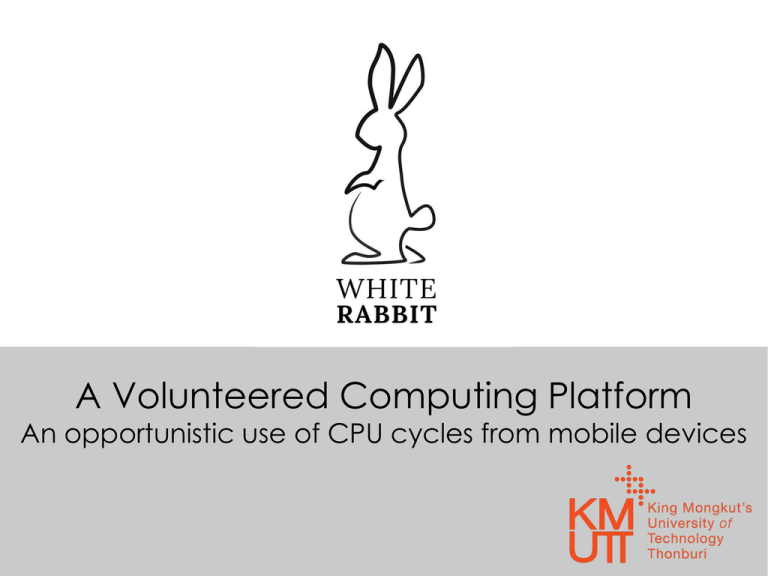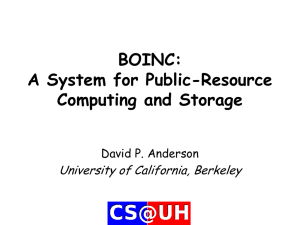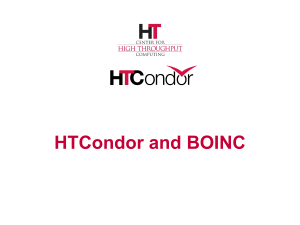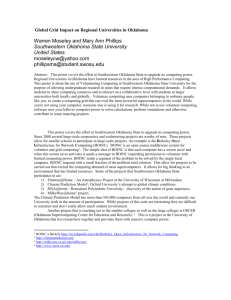03-white_rabbit - Indico
advertisement

A Volunteered Computing Platform An opportunistic use of CPU cycles from mobile devices Smartphone today • Smartphones and tablets are becoming increasingly powerful and rising quickly in popularity. Computing device sales comparison Smartphone charging behaviors A study on the availability of task execution periods • (presented in the CWC project) • Identify and attempt to utilize idle periods of smartphones • Profile the charging behaviors of users through an Android App • 3 states —> plugged, unplugged and shutdown • Tracks total bytes transmitted and received over WIFI and cellular network Smartphone charging behaviors (2) Charging interval: day—> 30 mins and night —> 7 hours User is unlikely to be actively using the phone at night, less than 2 MB Users have at least 3 hours of idle charging at night Volunteered Computing • Donation of CPU cycles to help solving scientific problems www.volunteer-computing.org Key Idea of White Rabbit Volunteered computing power for technological advancement in Sciences • • • Make use of idle computing resources. Promote the importance of Sciences. Create a new educational channel for sciences. White Rabbit will bring ALICE home to you White Rabbit: Aims & Objectives • To promote the ALICE Experiment to the communities (in Asia and Europe) • To promote sciences to young generations • To build a light weight mobile volunteered computing framework • To aggregate computing power of smartphones and exploit the wasted cycles of those devices while we sleep White Rabbit: The Plan for 2015-16 • Study, design and deploy a mobile volunteered computing platform (Most likely based on the BOINC framework). • Port a few of applications in the ALICE experiment (such as “TOF detector calibration”) onto White Rabbit • Validate the protocol • Evaluate the performance • Design new services: “rewarding scheme”, “social network Enabled”, and “education delivery” • Deliverables • White Rabbit (Implementation and Deployment) • New services as add-on modules • 1-2 Publications Notes on Related Technologies The Berkeley Open Infrastructure for Network Computing Use the idle time on your computer to cure diseases, study global warming, discover pulsars, and do many other types of scientific research. BOINC BOINC‘s Adoptions SETI@Home - 3 million participants - 600 TFLOPS Folding@home - 300,000 contributors - 5 PFLOPS sustained A research project that uses volunteered computing to run simulations of the ATLAS experiment • Hardware • • • A reasonably powerful modern 64-bit computer with at least 4GB of memory is required. Software • VirtualBox ~500MB • BOINC Client Each work unit downloads a small set of input data and runs for approximately 1 to 2 hours depending on the computer's processor speed. Virtual LHC@home • The Virtual LHC@home project (formerly known as Test4Theory) allows users to participate in running simulations of high-energy particle physics using their home computers. • The results are submitted to a database which is used as a common resource by both experimental and theoretical scientists working on the Large Hadron Collider at CERN. Limitations of BOINC • The BOINC server can only be executed on GNU/Linuxbased operating systems. • The platform is relatively heavy with lots of embedded modules. • Researchers creating BOINC projects must learn the BOINC programming API and be proficient in • • Linux system administration • MySQL administration • The Extensible Markup Language (XML), and C++. Limited documentation and very few tools to facilitate the creation of new projects, resulting in a long, manual process. SLINC Simple Light-weight Infrastructure for Network Computing The existing volunteer computing frameworks are too complex, limiting, and difficult to use for scientists. • Goal: to create a new framework that simplifies the process of creating volunteer computing projects. The framework should be scalable with modular and object-oriented design. • Server: partitioning input data into work units, distributing work units to clients, and processing and validating results for each work unit. • Client: request work units from the project server, compute the result for each work unit, and return the result to the server. • Each module can be located on different physical computers and all components can communicate via XML-RPC SLINC: Architecture Other Related Works • Ibis : an open source Java based high performance distributed computing platform with a version on Android. • AVRF : Android Volunteered Resource Framework, designed to allow Android phones to act as volunteer workers for distributed computing tasks. • Hyrax : A cloud computing platform on mobile devices using the Mapreduce concept. Why BOINC? • It’s the only platform with multiple actual usages in mega-science projects. • It’s a mature platform with relatively strong supporting communities. • So…...this is an easy decision! BOINCOID A Project aims at creating a volunteered computing platform on ARM-based mobile devices. HTC Power to Give Samsung Power Sleep Volunteered Computing on iPhone • Technical and legal barriers (It’s possible that in the future these issues can be overcome.) • Multitasking issues • Ability to control hardware resources on devices The 10 steps of TOF Detector Calibration 1 Collect input for computing ALICE DB Resource Manager 2 Query for tasks Resource Manager Wait for client connections 3 Await input data and Partition tasks upon receiving Resource Manager Wait for client connections 4 Collect user information Install the application Resource Manager Wait for clients 5 Sent request and resource status User click ‘run’ Resource Manager Scheduler distribute jobs • • User priority (complete and failure history) Machine’s resources 6 Send an input file Resource Manager Compute … Resource Manager Periodically Probe the devices 7 Send heartbeat requests to track jobs If fail to receive heartbeats, reschedule the old tasks Resource Manager Periodically collect the results 8 Send the partial results to server Finished Resource Manager Compile and Submit results 9 collect user’s computation time/failure Finished Resource Manager Compile and Submit results 10 Store results persistently ALICE DB TOF Detector streams real-time input Volunteer Input Receiver API receives input Devices Profiler Receiver collects devices profile Graphics User Interface interacts with volunteer Job Partitioning collect input to database Job Request Module sent request to server Job Scheduler collect input to database Device Profiler profiles device resource Job Distributer assign task to each devices and collect results Compute Node runs the tasks Job Tracker iterative tracks devices status (running, disappeared) Resource Manager Resource Manager Mobile Device 1 Input Collection Output Collection User Collection NoSQL Database collects input, output, users information Linux Server Logs Collection Mobile Device N Challenges Power - There is only a limited amount of power available on a mobile device at any given time. Platform - Distributed applications targeted at mobile platforms have to run on heterogeneous systems using a variety of hardware, OS and libraries. Network - A mobile device is often intermittently connected to a network and connects to a variety of networks including cellular, data, Wi-Fi. User concerns - Mobile device owners may be concerned with battery drainage and connectivity charges. Plans Power – Only activate computations when devices is being charged (Offline ALICE applications only) Platform – Android platform only (for now) Network – Transfer data over WiFi only. If offline, cache the results on the phone User concerns – Rewarding schemes will be implemented as a service to motivate users Gamification on Social networks Let’s share the wonderland of Sciences to the general public Happy Holidays References • Anderson, D. P., Cobb, J., Korpela, E., Lebofsky, M. and Werthimer, D., 2002 , “SETI@home: an experiment in public-resource computing”, Co mmunications of the ACM, , pp. 56-61. • E. Marinelli., 2009, “Hyrax: cloud computing on mobile devices using MapReduce.” Carnegie-mellon university Pittsburgh PA school of co mputer science. • J. Baldassari, D.Finkel and D. Toth, 2006, “SLINC: A Framework for volu nteer computing”, the 18th IASTED International Conference on Parall el and Distributed Computing and Systems • David P. Anderson, 2004, “BOINC: A System for Public-Resource Com puting and Storage”, 5th IEEE/ACM International Workshop on Grid C omputing • http://boinc.bakerlab.org/ TOF Detector • A particle detector which can discriminate between a lighter and a heavier elementary particle of same momentum using their time of flight between two scintillators. • Consists of inspecting a large number of events (>10^7) • Detecting a maximum and then merging all the results together CWC: Computing While Charging • Goal: To find an alternative way to run tasks by using the idle cycle of smartphone • Focus on energy-efficient and cost-effective • (a) profile a charging behaviours of real phone owners • (b) Implement android application that provide simple task migration, interrupted and resume task executions • (c) deploy a prototype of CWC and evaluate the result (with 18 Android smartphones) CWC: Computing While Charging • a central server partitions a large input file into smaller pieces • transmits the input partitions (together with the executable that processes the input) to the smartphones in CWC. • Upon receiving the executable and the corresponding input, the phones execute the task in parallel • Phones return results to the central server when they finish executing the task. • The central server performs a logical aggregation of the returned results CWC: Computing While Charging CBP: Complementary bin packing is the size (in KB) of job j’s executable is the time that it takes phone i to receive 1 KB of data from the server is the time that it takes for phone i to execute the job j on 1 KB of input data.





